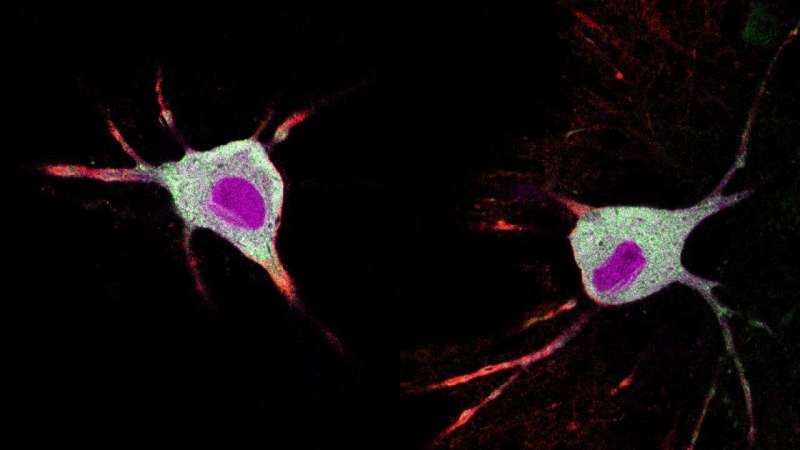This article has been reviewed according to Science X's editorial process and policies. Editors have highlighted the following attributes while ensuring the content's credibility:
fact-checked
peer-reviewed publication
trusted source
proofread
New method tracks how psychedelics affect neurons in minutes

Researchers at the University of California, Davis have developed a rapid, noninvasive tool to track the neurons and biomolecules activated in the brain by psychedelic drugs. The protein-based tool, which is called Ca2+-activated Split-TurboID, or CaST, is described in research published in Nature Methods.
There has been mounting interest in the value of psychedelic-inspired compounds as treatments for brain disorders including depression, post-traumatic stress disorder and substance use disorder. Psychedelic compounds like LSD, DMT and psilocybin promote the growth and strengthening of neurons and their connections in the brain's prefrontal cortex. The new tool could help scientists unlock the benefits of psychedelic treatments for patients with brain disorders.
"It's important to think about the cellular mechanisms that these psychedelics act upon," said Christina Kim, an assistant professor of neurology at the UC Davis Center for Neuroscience and School of Medicine, and an affiliate of the UC Davis Institute for Psychedelics and Neurotherapeutics. "What are they? Once we know that, we can design different variants that target the same mechanism but with fewer side effects."
This research provides scientists with a new technique that could be used to track step by step the molecular signaling processes that are responsible for these compounds' beneficial neuroplastic effects. What's more, CaST accomplishes the task of cellular tagging in rapid time, taking 10 to 30 minutes rather than the hours typical of other tagging methods.
"We designed these proteins in the lab that can be packaged into DNA and then put into harmless adeno-associated viruses," Kim said. "Once we deliver the CaST tool and these proteins into neurons, then they incubate inside the cells and start expressing."
The research was conducted in collaboration with David Olson, founding director of the Institute for Psychedelics and Neurotherapeutics and a professor in the departments of Chemistry and Biochemistry and Molecular Medicine.
A snapshot of the brain
The CaST tool takes advantage of changes in intracellular calcium concentrations, a nearly universal marker to track activity in a neuron. When neurons exhibit high activity, they exhibit high calcium levels. CaST uses this cue to tag the cell with a small biomolecule called biotin.
In the study, Kim and her colleagues dosed mice with the psychedelic psilocybin. They then used CaST in tandem with biotin to identify neurons with increased calcium in the prefrontal cortex. The prefrontal cortex is an area affected by many brain disorders and also an area where psychedelics promote neuronal growth and strengthening.
The researchers also monitoring the head-twitch responses in the mice. Head-twitch responses are the primary behavioral correlate for hallucinations caused by psychedelics.
"What's nice about CaST is that it can be used in a freely behaving animal," said Kim, noting that other cellular tagging technologies require stabilizing a mouse's head to accomplish imaging. "Biotin is also a great tagging substrate because there are many pre-existing commercial tools that can report whether biotin is present or not just by a simple staining and imaging method."
The proof-of-concept experiment gave what Kim called "a camera snapshot" of the areas in the prefrontal cortex activated by psilocybin.
Next steps
Kim and her colleagues are now working on methods to enable brain-wide cellular labeling with the CaST tool. Additionally, they're exploring ways to enrich the signature of individual proteins produced by neurons affected by psychedelics.
"We can send those samples to the UC Davis Proteomics Core Facility and they can give us an unbiased picture of all the proteins we identified," Kim said. "We want to examine their entire contents in terms of what proteins they express, what genes they express, and try to see what's different in psilocybin-treated animals versus control animals or animal models of diseases."
The goal is to identify how psychedelics benefit the cellular profiles of those with brain disorders, elucidating the step-by-step cellular process of their therapeutic effects.
Kim expressed interest in conducting future experiments in collaboration with Olson's lab that use the CaST tool to compare the neuronal activity induced by psychedelics to the activity induced by non-hallucinogenic neurotherapeutics.
"CaST will be an important tool for studying the mechanisms of action of these neurotherapeutic drugs," Kim said.
Additional UC Davis authors on the study include lead authors Run Zhang and Maribel Anguiano, and Isak K. Aarrestad, Sophia Lin, Joshua Chandra and Sruti S. Vadde.
More information: Run Zhang et al, Rapid, biochemical tagging of cellular activity history in vivo, Nature Methods (2024). DOI: 10.1038/s41592-024-02375-7




















